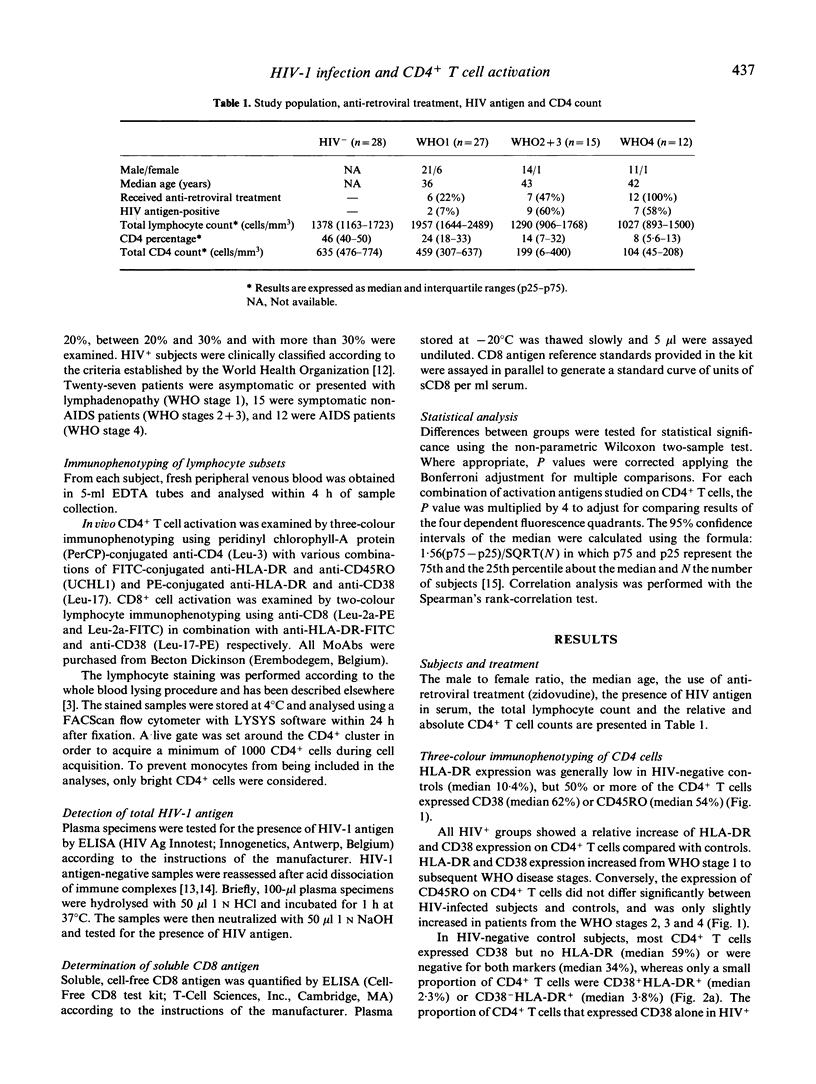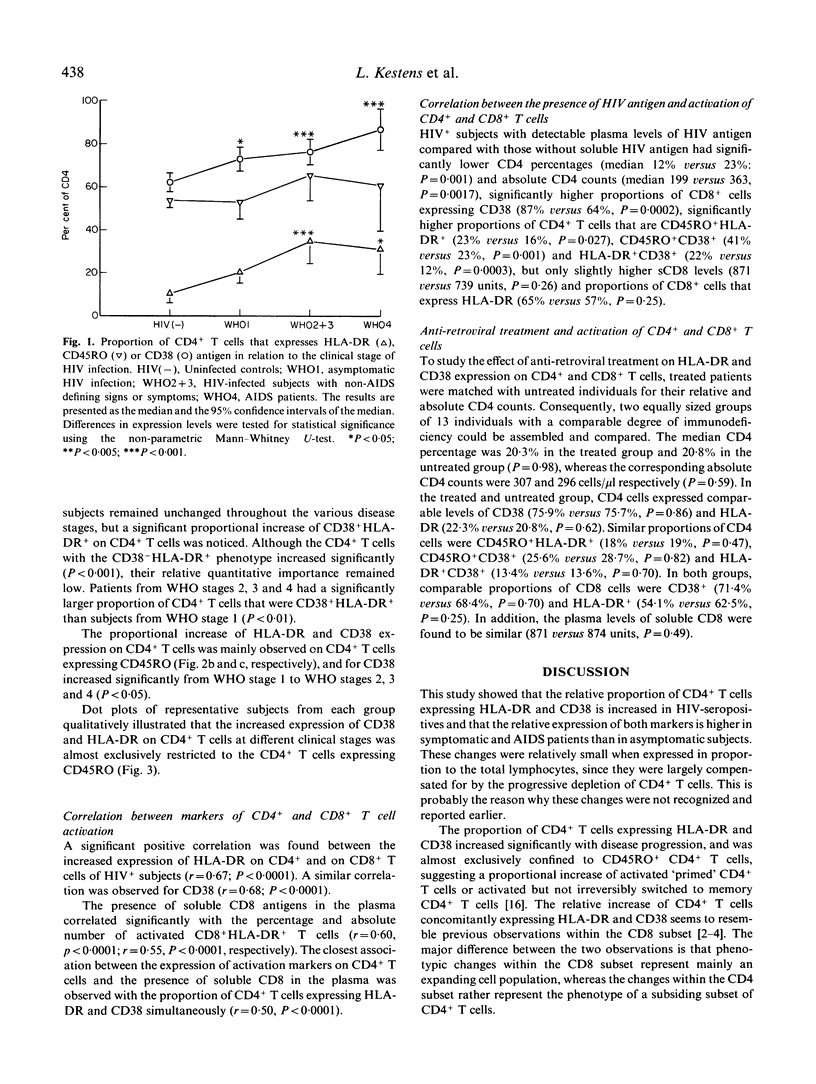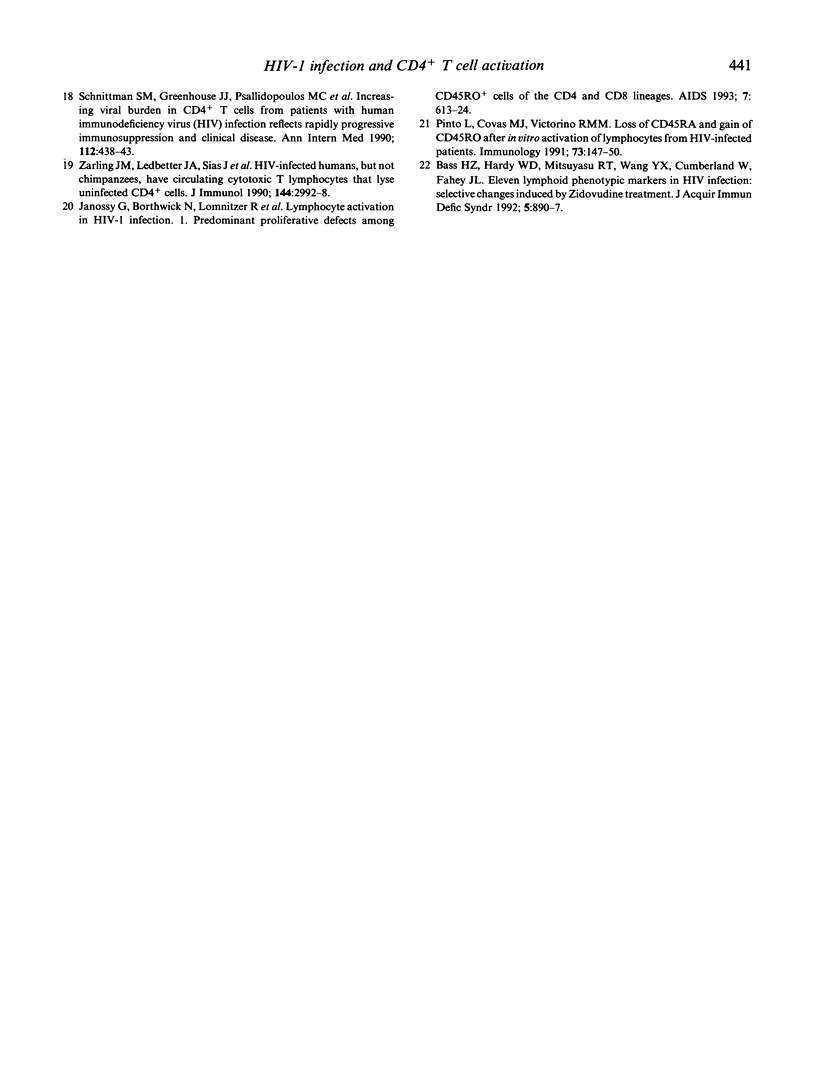Abstract
Infection with HIV results in a progressive depletion of CD4+ T cells and leads to significant in vivo lymphocyte phenotype changes. In this regard, the expression of HLA-DR and CD38 on CD8+ T cells has been shown to increase dramatically with disease progression. We investigated the expression of both activation markers on CD4+ T cells in HIV-1-infected subjects at different clinical stages of infection and compared the in vivo activation of CD4+ T cells with parameters of viral activity and CD8+ T cell activation. Fresh peripheral venous blood was obtained from 54 HIV-infected subjects and from 28 uninfected healthy controls. Three-colour immunophenotyping of the CD4+ T cell subset showed that the proportion of CD4+ T cells expressing HLA-DR (10% in HIV-negative controls) or CD38 (62% in HIV-negative controls) was higher in asymptomatic (P < 0.05 for CD38) and symptomatic (P < 0.001 for HLA-DR and CD38) HIV-infected subjects than in controls, whereas the proportion of CD4+ T cells expressing CD45RO (54% in controls) remained relatively unchanged. Simultaneous expression of HLA-DR and CD38 on CD4+ T cells increased from 2.3% in controls to 11% (P < 0.001) in asymptomatic and 22% (P < 0.001) in symptomatic HIV-infected subjects. This relative increase of CD38 and HLA-DR expression occurred mainly on CD4+ T cells co-expressing CD45RO. Changes in expression of HLA-DR and CD38 on CD4+ T cells correlated with similar changes on CD8+ T lymphocytes, with the presence of HIV antigen in the circulation, and with the disease stage of HIV infection.
Full text
PDF





Selected References
These references are in PubMed. This may not be the complete list of references from this article.
- Ascher M. S., Sheppard H. W. AIDS as immune system activation. II. The panergic imnesia hypothesis. J Acquir Immune Defic Syndr. 1990;3(2):177–191. [PubMed] [Google Scholar]
- Bass H. Z., Hardy W. D., Mitsuyasu R. T., Wang Y. X., Cumberland W., Fahey J. L. Eleven lymphoid phenotypic markers in HIV infection: selective changes induced by zidovudine treatment. J Acquir Immune Defic Syndr. 1992;5(9):890–897. [PubMed] [Google Scholar]
- Fahey J. L., Taylor J. M., Detels R., Hofmann B., Melmed R., Nishanian P., Giorgi J. V. The prognostic value of cellular and serologic markers in infection with human immunodeficiency virus type 1. N Engl J Med. 1990 Jan 18;322(3):166–172. doi: 10.1056/NEJM199001183220305. [DOI] [PubMed] [Google Scholar]
- Jackson D. G., Bell J. I. Isolation of a cDNA encoding the human CD38 (T10) molecule, a cell surface glycoprotein with an unusual discontinuous pattern of expression during lymphocyte differentiation. J Immunol. 1990 Apr 1;144(7):2811–2815. [PubMed] [Google Scholar]
- Janossy G., Borthwick N., Lomnitzer R., Medina E., Squire S. B., Phillips A. N., Lipman M., Johnson M. A., Lee C., Bofill M. Lymphocyte activation in HIV-1 infection. I. Predominant proliferative defects among CD45R0+ cells of the CD4 and CD8 lineages. AIDS. 1993 May;7(5):613–624. doi: 10.1097/00002030-199305000-00002. [DOI] [PubMed] [Google Scholar]
- Kestens L., Hoofd G., Gigase P. L., Deleys R., van der Groen G. HIV antigen detection in circulating immune complexes. J Virol Methods. 1991 Jan;31(1):67–76. doi: 10.1016/0166-0934(91)90145-p. [DOI] [PubMed] [Google Scholar]
- Kestens L., Vanham G., Gigase P., Young G., Hannet I., Vanlangendonck F., Hulstaert F., Bach B. A. Expression of activation antigens, HLA-DR and CD38, on CD8 lymphocytes during HIV-1 infection. AIDS. 1992 Aug;6(8):793–797. doi: 10.1097/00002030-199208000-00004. [DOI] [PubMed] [Google Scholar]
- Levacher M., Hulstaert F., Tallet S., Ullery S., Pocidalo J. J., Bach B. A. The significance of activation markers on CD8 lymphocytes in human immunodeficiency syndrome: staging and prognostic value. Clin Exp Immunol. 1992 Dec;90(3):376–382. doi: 10.1111/j.1365-2249.1992.tb05854.x. [DOI] [PMC free article] [PubMed] [Google Scholar]
- Nishanian P., Huskins K. R., Stehn S., Detels R., Fahey J. L. A simple method for improved assay demonstrates that HIV p24 antigen is present as immune complexes in most sera from HIV-infected individuals. J Infect Dis. 1990 Jul;162(1):21–28. doi: 10.1093/infdis/162.1.21. [DOI] [PubMed] [Google Scholar]
- Osmond D. H., Shiboski S., Bacchetti P., Winger E. E., Moss A. R. Immune activation markers and AIDS prognosis. AIDS. 1991 May;5(5):505–511. doi: 10.1097/00002030-199105000-00005. [DOI] [PubMed] [Google Scholar]
- Pinto L., Covas M. J., Victorino R. M. Loss of CD45RA and gain of CD45RO after in vitro activation of lymphocytes from HIV-infected patients. Immunology. 1991 Jun;73(2):147–150. [PMC free article] [PubMed] [Google Scholar]
- Prince H. E., Czaplicki C. D. Preferential loss of Leu 8-, CD45R, HLA-DR+ CD8 cell subsets during in vitro culture of mononuclear cells from human immunodeficiency virus type I (HIV)-seropositive former blood donors. J Clin Immunol. 1989 Sep;9(5):421–428. doi: 10.1007/BF00917108. [DOI] [PubMed] [Google Scholar]
- Prince H. E., Jensen E. R. Three-color cytofluorometric analysis of CD8 cell subsets in HIV-1 infection. J Acquir Immune Defic Syndr. 1991;4(12):1227–1232. [PubMed] [Google Scholar]
- Prince H. E., York J., Jensen E. R. Phenotypic comparison of the three populations of human lymphocytes defined by CD45RO and CD45RA expression. Cell Immunol. 1992 Dec;145(2):254–262. doi: 10.1016/0008-8749(92)90329-n. [DOI] [PubMed] [Google Scholar]
- Reddy M. M., Grieco M. H. Quantitative changes in T helper inducer (CD4+ CD45RA-), T suppressor inducer (CD4+ CD45RA+), T suppressor (CD8+ CD11b+), and T cytotoxic (CD8+ CD11b-) subsets in human immunodeficiency virus infection. J Clin Lab Anal. 1991;5(2):96–100. doi: 10.1002/jcla.1860050205. [DOI] [PubMed] [Google Scholar]
- Schnittman S. M., Greenhouse J. J., Psallidopoulos M. C., Baseler M., Salzman N. P., Fauci A. S., Lane H. C. Increasing viral burden in CD4+ T cells from patients with human immunodeficiency virus (HIV) infection reflects rapidly progressive immunosuppression and clinical disease. Ann Intern Med. 1990 Sep 15;113(6):438–443. doi: 10.7326/0003-4819-113-6-438. [DOI] [PubMed] [Google Scholar]
- Vanham G., Kestens L., Penne G., Goilav C., Gigase P., Colebunders R., Vandenbruaene M., Goeman J., van der Groen G., Ceuppens J. L. Subset markers of CD8(+) cells and their relation to enhanced cytotoxic T-cell activity during human immunodeficiency virus infection. J Clin Immunol. 1991 Nov;11(6):345–356. doi: 10.1007/BF00918800. [DOI] [PubMed] [Google Scholar]
- Vuillier F., Lapresle C., Dighiero G. Comparative analysis of CD4-4B4 and CD4-2H4 lymphocyte subpopulations in HIV negative homosexual, HIV seropositive and healthy subjects. Clin Exp Immunol. 1988 Jan;71(1):8–12. [PMC free article] [PubMed] [Google Scholar]
- Zarling J. M., Ledbetter J. A., Sias J., Fultz P., Eichberg J., Gjerset G., Moran P. A. HIV-infected humans, but not chimpanzees, have circulating cytotoxic T lymphocytes that lyse uninfected CD4+ cells. J Immunol. 1990 Apr 15;144(8):2992–2998. [PubMed] [Google Scholar]
- Zola H., Flego L., Macardle P. J., Donohoe P. J., Ranford J., Roberton D. The CD45RO (p180, UCHL1) marker: complexity of expression in peripheral blood. Cell Immunol. 1992 Nov;145(1):175–186. doi: 10.1016/0008-8749(92)90321-f. [DOI] [PubMed] [Google Scholar]


